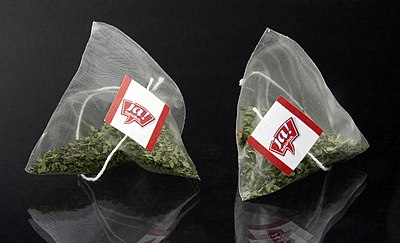Tea bag

A tea bag is a small, porous sealed bag containing tea leaves and used for brewing tea, or herbs or spices for brewing tisanes. Tea bags are commonly made of paper, silk or plastic. The bag contains the tea leaves while the tea is brewed, making it easier to dispose of the leaves, and performs the same function as a tea infuser. Some tea bags have an attached piece of string with a paper label at the top that assists in removing the bag while also identifying the variety of tea.
In countries where the use of loose tea leaves is more prevalent, the term tea bag is commonly used to describe paper or foil packaging for loose leaves. They are usually square or rectangular envelopes with the brand name, flavour and decorative patterns printed on them.
History
The first tea bags were hand-sewn silk bags and tea bag patents date as early as 1903. First appearing commercially around 1904, tea bags were successfully marketed by the tea and coffee shop merchant Thomas Sullivan from New York, who shipped his tea bags around the world. The loose tea was intended to be removed from the bags by customers, but they found it easier to prepare tea with the tea enclosed in the bags.[1] Modern tea bags are usually made of paper fibre. The heat-sealed paper fiber tea bag was invented by William Hermanson,[2] one of the founders of Technical Papers Corporation of BostonTemplate:Citation needed. Hermanson sold his patent to the Salada Tea Company in 1930.Template:Citation needed
The rectangular tea bag was not invented until 1944. Prior to this tea bags resembled small sacks.[1]
Production
Teas
A broad variety of teas, as well as other infusions like tisanes, are available in tea bags. Typically, tea bags use fannings, the left-overs after larger leaf pieces are gathered for sale as loose tea, but some companies such as Honest Tea sell teabags containing whole-leaf tea.[3]
Paper
Tea bag paper is related to paper found in milk and coffee filters and is a blend of wood and vegetable fibers. The vegetable fiber is bleached pulp abaca hemp, a small plantation tree grown for its fiber, mostly in the Philippines and Colombia. Heat-sealed tea bag paper usually has a heat-sealable thermoplastic such as PVC or polypropylene as a component fiber on the inner tea bag surface. Template:-
Bagging
The top tea-bagging machine companies in the world are MAI from Mar del Plata, Argentina[4] with customers in 78 countries[5] and innovating designs,[6] Teepack from Meerbusch, Germany,[7] and IMA, from Bologna, Italy.[8] A standard machine produced by the MAI company can fill 120 rectangular bags per minute[9] containing up to 3.3 grams per bag, which allows the packaging of tisanes. Another company, the Italian Tecnomeccanica, has a faster design capable of filling 250 pyramidal bags per minute.[10]
Tea bag shapes
Traditionally, tea bags have been square or rectangular in shape. More recently circular and pyramidal bags have come on the market and are often claimed by their manufacturers to improve the quality of the brew.
Empty tea bags are also available for consumers to fill with tea leaves themselves. These are typically open-ended pouches with long flaps. The pouch is filled with an appropriate quantity of leaf tea and the flap is closed into the pouch to retain the tea. Such tea bags combine the ease of use of a commercially-produced tea bag with the wider tea choice and better quality control of loose leaf tea.
Because of the convenience of tea bags, a wide variety of herbs can be purchased as "tea bag cut", a grade which is specified in terms of particle size, typically with the bulk of the leaves around 1 - 1.5 mm.Template:Fact
The nylon pyramidal tea bag containing larger tea leaf fragments made an appearance in the marketplace for aficionados. The pyramidal shape allows more room for the leaf to steep. Environmentalists prefer silk to nylon because of health and biodegradability issues.[11] Another material for tea bags is Soilon, made from corn starch.[12]
Coffee
The concept of pre-measured portions to be infused in disposable bags has also been applied to instant coffee, although this has not achieved such wide market penetration (similar to the market penetration of instant tea as compared to instant coffee).
Decorative tea bags have become the basis for large collections and many collectors collect tea bags from around the world.
Teabag folding began in the Netherlands and is often credited to Tiny van der Plas. It is a form of origami in which identical squares of patterned paper (cut from the front of tea bag sachets) are folded, and then arranged in rosettes. These rosettes are usually used to decorate gift cards and it has become a popular craft in both the US and UK since 2000.[13]
Cold tea bags are used as a treatment for sunburn and arc eye.Template:Citation needed
References
az:Çay paketi br:Sac'hadig te ca:Bossa de te cs:Čajový sáček fa:چای کیسهای ko:티백 is:Tepoki nl:Theezakje ja:ティーバッグ ru:Чайный пакетик fi:Teepussi sv:Påste tl:Supot ng tsaa war:Supot hin seminte



